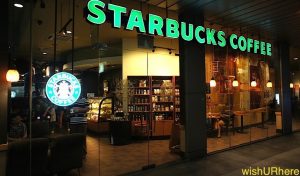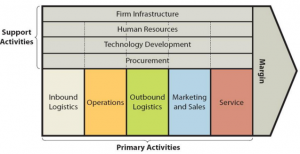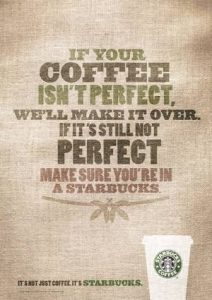Strong Value Chain Helps Build Brand Equity
The concept of the value chain was coined and explained by Michael Porter in his popular book “Competitive Advantage: Creating and Sustaining Superior Performance” in 1985. Value chain is a sequence of activities or practices which aims at creating and adding value to a product or a service. Value is added at every process of doing business. Businesses aim at enhancing their margins and thus they need to work on their operating procedure carefully. Businesses work to change input into an output by adding greater value in it. Thus the logic behind it is simple; the more value a company creates, the more profitable it becomes. When more value is created, the same is passed on to the customers and thus further helps in combining a competitive edge. One happy customers gets ten more customers. Value adds brand loyalty and brand awareness in markets. The primary activities of value chain are inbound logistics, operation, outbound logistics, marketing & sales and after sales service. These primary activities are supported by procurement, technology, human resource management and firm’s infrastructure. Products pass through a chain of activities in order, and at each activity the product gains some value.
Processes that go in primary and supporting activities of value chain are as follows:
Primary activities:
Inbound Logistics: involves relationships with suppliers and it includes all activities required to from placing order for raw material, receiving it, storing it, stacking it and circulate inputs. Inbound logistics is associated with receiving, storing, disseminating inputs for the operation such as material handling, warehousing, and inventory control, vehicle scheduling and servicing the suppliers.
Operations: involves all the activities required to transform inputs into outputs (products and services). For example machining, packing assembly, equipment maintenance, testing, printing pasting, stacking and facility operations.
Outbound Logistics: is associated with distribution. All activities required to collect, store, and distribute the finished product. It includes reaching the finished goods to the point of consumption. Warehousing, material handling, routing, selection of routes, mode of transport, order processing and scheduling.
Marketing and Sales: activities include market research, segmenting market, sales promotional activities, developing, positioning and branding. Marketing and sales activities inform buyers about products and services. The activities in marketing facilitate the purchase with advertising, promotion, sales force size, training and developing, channel selection, channel relation and pricing.
After Sales Service: includes all the activities required to keep the product or service working effectively for the buyer after it is sold and delivered. Such as installation, repair, training, parts supply and product adjustment
Support activities:
Procurement: is the acquisition of inputs, or resources, for the firm.
Human Resource management: This consists of all activities involved in recruiting, hiring, salary, training, developing, compensating, motivation and performance appraisal. A transparent, ethical Performance Appraisal system is never demoralizing or inhuman. What’s inhumane is failing to make the organization’s standards and values clear and transparent and not letting people know where they stand.
Technological Development: It pertains to the equipment, hardware, software, procedures and technical knowledge brought to bear in the firm’s transformation of inputs into outputs. The digital revolution has created an Information Age.
Company’s infrastructure: this facet shows a company physical infrastructure, intellectual infrastructure, human infrastructure, digital infrastructure etc. In short, it refers to internal strengths of the company and how well connected it is externally.
Example of Starbucks for a better understanding of value chain: The Starbucks journey began with a single store in Seattle in the year 1971 by three partners who met while they were students at the University of San Francisco: English teacher Jerry Baldwin, history teacher Zev Siegl, and writer Gordon Bowker. To become one of the most recognized brands globally, Starbucks planned a mission statement “to inspire and nurture the human spirit – one person, one cup and one neighborhood at a time.” To achieve the mission the organizations concentrates on all primary activities such as:
Primary activities:
Inbound Logistics: The inbound logistics for Starbucks refers to selecting the finest quality of coffee beans from the coffee producers in Latin America, Africa and Asia. In the case of Starbucks, the green or unroasted beans are procured directly from the farms by the Starbucks buyers. These are transported to the storage sites after which the beans are roasted and packaged. The ready beans are sent to the distribution centers few of which are company owned and some are operated by other logistic companies. The company itself does the procurement to ensure high quality standards right from the point of selection of coffee beans.
Operations: Starbucks operates in 65 countries either in the form of direct stores operated by the company or as licensed stores. Starbucks has more than 21,000 stores internationally which includes Starbucks Coffee, Teavana, Seattle’s Best Coffee and Evolution Fresh retail locations. According to its sales figures, the company generated 79% of the total revenue during fiscal year 2013 from its company operated stores while the licensed stores accounted for 9% of the revenue.
Outbound Logistics: There is very little or no presence of intermediaries in product selling. Majority of the products are sold in their own or licensed stores only. As a new venture, the company has launched a new range of single-origin coffees which is sold through some leading retailers in the U.S. such as Guatemala Laguna de Ayarza, Rwanda Rift Valley and Timor Mount Ramelau.
Marketing and Sales: Starbucks invests in superior quality products and high level of customer services than aggressive marketing. However, need based marketing activities are carried out by the company during new products launches in the form of sampling in areas around the stores. At Starbucks at a point in time, some of their executives visited their coffee shops and noticed that good employees were losing their poise when faced with agitated customers. Instead of coming down on the individual employees, they developed new training material that eliminated the stress of these situations. The executives at Starbucks found that when they empowered their employees with tools they needed to serve customers happily, their employees gained their smiles back.
After sales service: Starbucks aims at building customer loyalty through high level of customer service at its stores. The retail objective of Starbucks is, as it says in its annual report, “to be the leading retailer and brand of coffee in each of our target market by selling the finest quality coffee and related products, and by providing each customer a unique Starbucks Experience.”
Support Activities:
Infrastructure: This includes all departments like management, finance, legal, etc which are required to keep the company’s stores operational. Starbucks well designed and pleasing stores are complemented with good customer service provided by the dedicated team of employees in green aprons.
Human Resource Management: The Company’s committed workforce is considered a key attribute in the company’s success and growth over the years. Starbucks employees are motivated through generous benefits and incentives. The company is known for taking care of its workforce and this is perhaps the reason for a low turnover of employees, which indicates great human resource management. There are many training programs conducted for employees in a setting of a work culture which keeps its staff motivated and efficient.
Technology Development: Starbucks is very well known for use of technology not only for coffee related processes (to ensure consistency in taste and quality along with cost savings) but to connect to its customers. Many customers use Starbucks stores as a make shift office or meeting place because of the free and unlimited wifi availability. The company in the year 2008 also launched mystarbucksidea.force.com as a platform where customers can ask questions, give suggestions and openly express opinions and share experiences. The company has implemented some of the suggestions given via this forum. Starbucks also uses Apple’s iBeacon System wherein customers can order their drink through the Starbucks phone app and get a notification when they walk in the store. Thus, Starbuck uses the available technology to their fullest strength.
Procurement: This involves procuring the raw material for the final product. The company agents travel to Asia, Latin America and Africa for the procurement of high grade raw material to bring the finest coffee to its customers. The agents establish strategic relationship and partnership with a supplier which is built up after reconnaissance and communication about the company standards. High quality standards are maintained with direct involvement of the company right from the base level of selecting the finest raw material which is coffee beans in case of Starbucks.
Conclusions: Starbuck’s rivals benchmark their business processes.
















































